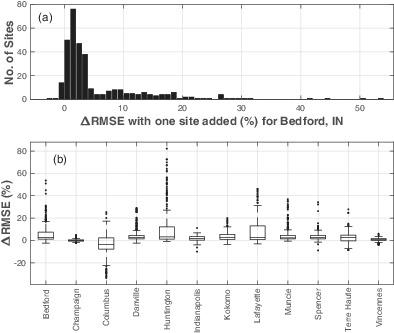当前位置:
X-MOL 学术
›
Hydrol. Process.
›
论文详情
Our official English website, www.x-mol.net, welcomes your
feedback! (Note: you will need to create a separate account there.)
A machine learning approach to water quality forecasts and sensor network expansion: Case study in the Wabash River Basin, United States
Hydrological Processes ( IF 2.8 ) Pub Date : 2022-05-26 , DOI: 10.1002/hyp.14619 Tyler Balson 1 , Adam S. Ward 2, 3
Hydrological Processes ( IF 2.8 ) Pub Date : 2022-05-26 , DOI: 10.1002/hyp.14619 Tyler Balson 1 , Adam S. Ward 2, 3
Affiliation

|
Midwestern cities require forecasts of surface nitrate loads to bring additional treatment processes online or activate alternative water supplies. Concurrently, networks of nitrate monitoring stations are being deployed in river basins, co-locating water quality observations with established stream gauges. However, tools to evaluate the future value of expanded networks to improve water quality forecasts remains challenging. Here, we construct a synthetic data set of stream discharge and nitrate for the Wabash River Basin—one of the United States’ most nutrient polluted basins—using the established Agro-IBIS and THMB models. Synthetic data enables rapid, unbiased and low-cost assessment of potential sensor placements to support management objectives, such as near-term forecasting. Using the synthetic data, we established baseline 1-day forecasts for surface water nitrate at 12 cities in the basin using support vector machine regression (SVMR; RMSE 0.48–3.3 ppm). Next, we used the SVMRs to evaluate the improvement in forecast performance associated with deployment of additional nitrate sensors. We identified the optimal sensor placement to improve forecasts at each city, and the relative value of sensors at each candidate location. Finally, we assessed the co-benefit realized by other cities when a sensor is deployed to optimize a forecast at one city, finding significant positive externalities in all cases. Ultimately, our study explores the potential for machine learning to make near-term predictions and critically evaluate the improvement realized by expanding a monitoring network. While we use nitrate pollution in the Wabash River Basin as a case study, this approach could be readily applied to any problem where the future value of sensors and network design are being evaluated.
中文翻译:

水质预测和传感器网络扩展的机器学习方法:美国沃巴什河流域的案例研究
中西部城市需要预测地表硝酸盐负荷,以使额外的处理过程在线或激活替代供水。同时,硝酸盐监测站网络正在流域部署,将水质观测与已建立的流量测量仪放在一起。然而,评估扩展网络的未来价值以改善水质预测的工具仍然具有挑战性。在这里,我们使用已建立的 Agro-IBIS 和 THMB 模型构建了 Wabash 河流域(美国营养污染最严重的流域之一)的河流排放和硝酸盐的合成数据集。综合数据可以对潜在传感器放置进行快速、公正和低成本的评估,以支持管理目标,例如近期预测。使用合成数据,我们使用支持向量机回归(SVMR;RMSE 0.48-3.3 ppm)建立了流域 12 个城市地表水硝酸盐的基线 1 天预测。接下来,我们使用 SVMR 评估与部署额外硝酸盐传感器相关的预测性能改进。我们确定了最佳传感器位置,以改善每个城市的预测,以及每个候选位置的传感器的相对价值。最后,我们评估了在部署传感器以优化一个城市的预测时其他城市实现的协同效益,在所有情况下都发现了显着的正外部性。最终,我们的研究探索了机器学习进行近期预测并批判性地评估通过扩展监控网络实现的改进的潜力。
更新日期:2022-05-26
中文翻译:

水质预测和传感器网络扩展的机器学习方法:美国沃巴什河流域的案例研究
中西部城市需要预测地表硝酸盐负荷,以使额外的处理过程在线或激活替代供水。同时,硝酸盐监测站网络正在流域部署,将水质观测与已建立的流量测量仪放在一起。然而,评估扩展网络的未来价值以改善水质预测的工具仍然具有挑战性。在这里,我们使用已建立的 Agro-IBIS 和 THMB 模型构建了 Wabash 河流域(美国营养污染最严重的流域之一)的河流排放和硝酸盐的合成数据集。综合数据可以对潜在传感器放置进行快速、公正和低成本的评估,以支持管理目标,例如近期预测。使用合成数据,我们使用支持向量机回归(SVMR;RMSE 0.48-3.3 ppm)建立了流域 12 个城市地表水硝酸盐的基线 1 天预测。接下来,我们使用 SVMR 评估与部署额外硝酸盐传感器相关的预测性能改进。我们确定了最佳传感器位置,以改善每个城市的预测,以及每个候选位置的传感器的相对价值。最后,我们评估了在部署传感器以优化一个城市的预测时其他城市实现的协同效益,在所有情况下都发现了显着的正外部性。最终,我们的研究探索了机器学习进行近期预测并批判性地评估通过扩展监控网络实现的改进的潜力。











































 京公网安备 11010802027423号
京公网安备 11010802027423号